Delicious soft homemade cheese bread, made two ways – a lovely Cheddar cheese version and a Parmesan and Herb version.
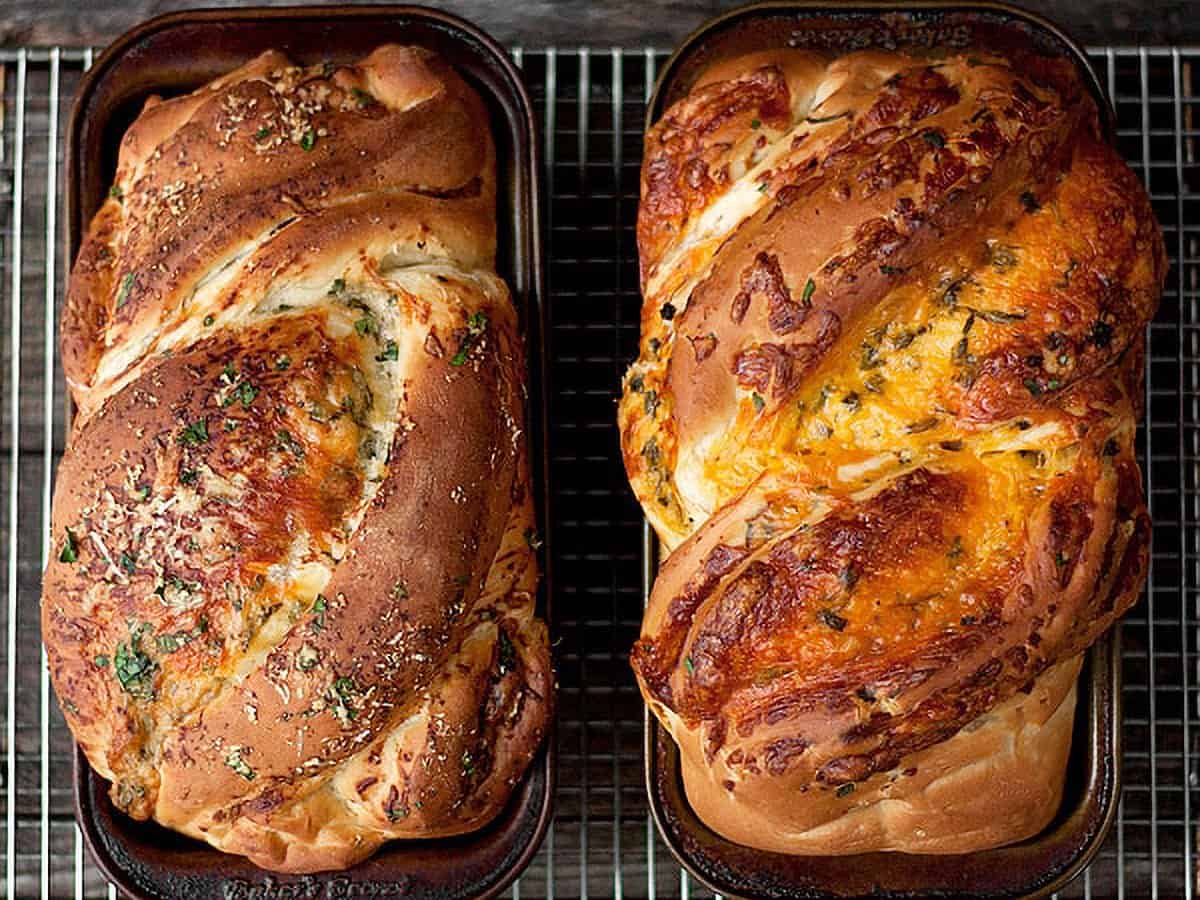
This is my absolute favourite cheese bread recipe! The dough is a dream to work with and the unique shaping makes for a pretty loaf with none of those cheese bread dreaded gaps.
Ingredients and substitutions
A few notes about the key ingredients …
Bread Flour – high protein bread flour will provide the nicest texture for your finished loaf. If you only have all-purpose flour, you can use it, but do note that you may need to add a bit more flour to get that moist, smooth dough when using all purpose flour. The texture of your loaf will be slightly heavier than it would have been if using bread flour, but will still be nice and soft.
Yeast – Regular Instant Yeast, such as SAF Brand is specified here. Quick or rapid-rising Instant yeast is NOT recommended. If you only have Dry Active Yeast, you can use it, but you will have to proof it in the warm water portion for the dough first (add a pinch of sugar), and then add to the dough when the water is specified.
Milk – you can use either milk or buttermilk here. For milk, anything 1% or higher is best. I like to use whole milk (3.5% b.f.), when I can. If you don’t have buttermilk, but would like a bit of buttermilk flavour, you can mix the 1 cup milk with 1 Tbsp of either lemon juice or white vinegar, then let it stand 10 minutes until thickened.
Cheese – use a sharp cheddar cheese for best flavour and grate it yourself. I find a yellow cheddar makes a prettier loaf, as you can see the cheese, but an old white cheddar also works here.
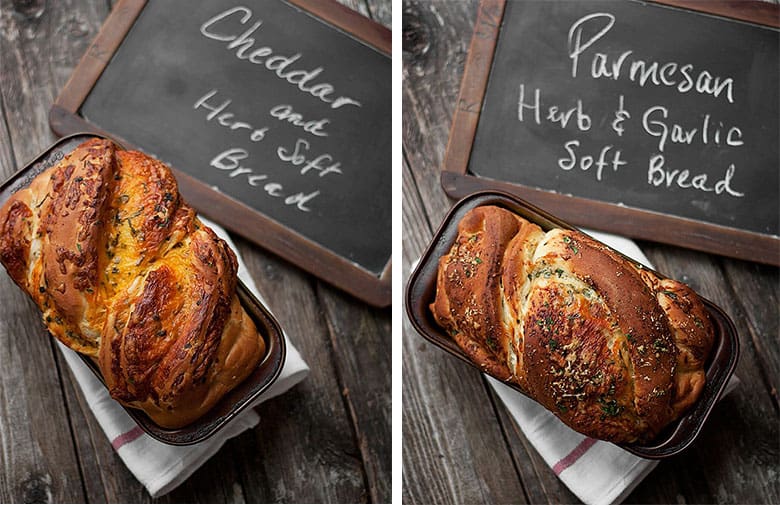
Recipe video
Confused about how this cheese bread is shaped? Watch the video, that shows how easy it is!
Recipe tips!
- This bread is endlessly customizable. All kinds of cheese, herb and other add-in combinations will work. Want to throw in some sun-dried tomatoes and/or a bit of pesto? Why not! Olives? Sure. Lots of cheese or just a bit? It’s up to you.
- This recipe will make two loaves of bread. You can make one of each – one cheddar and one Parmesan and herb – or you can just make two of the same one. Do note that the ingredients for the filling in the Recipe Card are for one loaf, so if you want to make two of the same loaf, simply double the filling amounts.
- Finally, there is an option to overnight-rise this dough in the fridge. I rarely do that, because I’m a) impatient and b) not that organized, but feel free to do so. There’s no doubt that any bread benefits from a longer rise for better flavour.
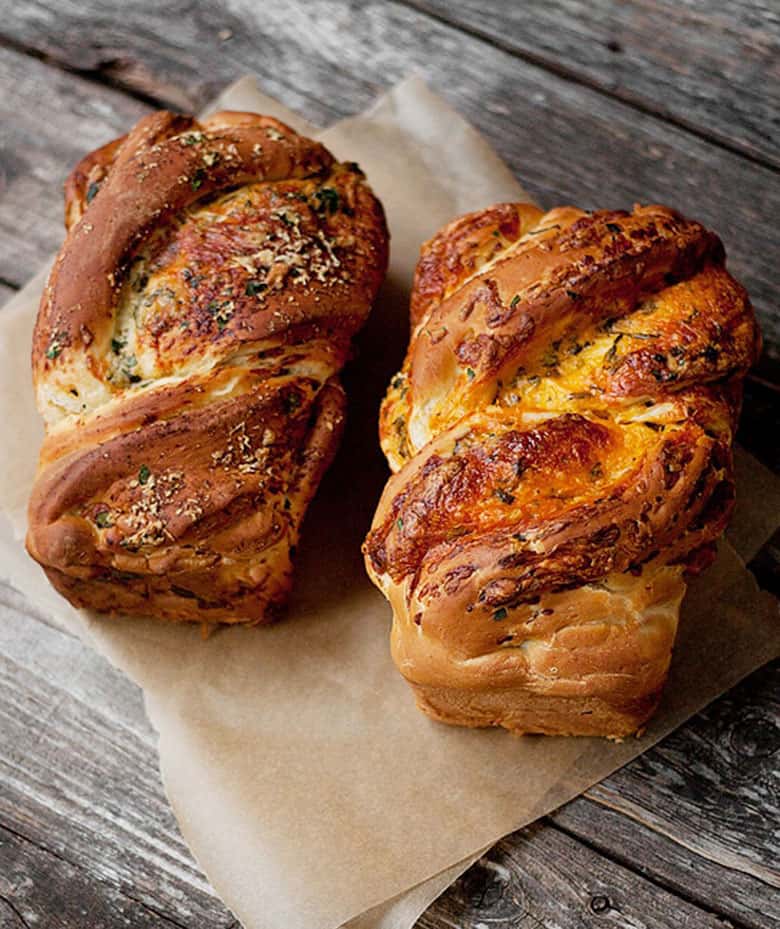
Tips for baking with yeast
I think most of the problems people have when starting out baking with yeast, is treating yeast-based recipes like say, a cake recipe, where you just measure the ingredients, mix them all together and bake.
Yeast-based recipes will never be that precise. Things like kitchen temperature, humidity, moisture in the flour you are using, the season your are baking in and rising time can differ from one kitchen to the next. All that makes yeast recipes less consistent from one kitchen to the next.
Now that you know this though, that’s more than half the battle :) What you’ll need to add to the mix to be a successful bread baker is some trust in what you see and feel. Does the dough look and feel too sticky? Add a bit more flour (regardless of how much flour the recipe says should go in.) Does the dough look nice and smooth before you’ve added all the flour specified? Trust it and don’t add any more flour. How much has the dough actually risen? When it comes to rising time, trust your eyes and not the clock. Trust what you SEE and FEEL and don’t be too tightly tied to the specifics of the recipe. Do that, and all will be good!
- Be careful with the temperature of your proofing liquid before adding the yeast, so you don’t compromise the yeast from the start. If the liquid is too cold, the yeast won’t activate. Too hot and it will die. The best temperature range for proofing liquid is 105-110F for Active Dry Yeast. Instant yeast is a bit more forgiving and can take temperatures up to 120F. All yeasts die at about 140°F. An Instant Read thermometer is handy to have on hand to check.
- Always treat the amount of flour specified in yeast-based recipes as “approximate”. Flours will vary from kitchen to kitchen and by season, so the amount needed to make a smooth, soft dough will vary.
- Given tip #2, I always hold back 1/4-1/3 of the flour specified in a recipe and add in only as much as is needed. If you dump all the flour in at the start, you may find that it is too much and it’s difficult to adjust well after that.
- Use a large glass measuring cup to proof the dough, if you can. The markings on the measuring cup make it easy to see when the dough has doubled.
- Be patient. Rising times are also “approximate” and will vary as well. Trust what you see and not the clock.
Want to save this recipe?
Enter your email and I’ll send it to your inbox. Plus, you’ll get great new recipes from me every week!
By submitting this form, you consent to receive emails from Seasons and Suppers.
You can unsubscribe at any time.
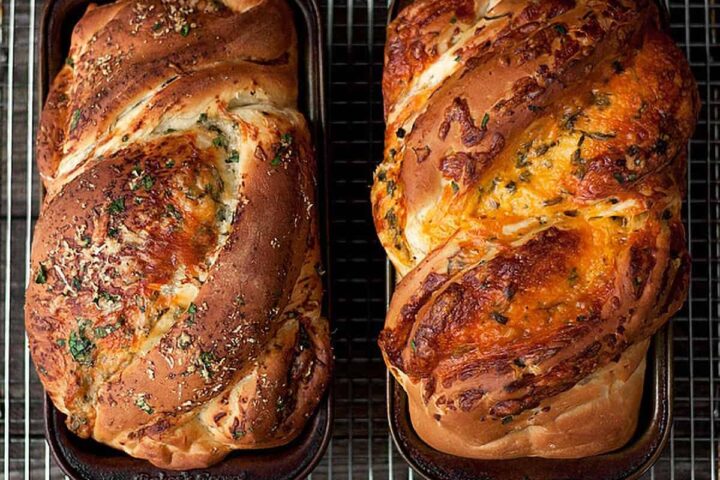
Get the Recipe: Simply Perfect Homemade Cheese Bread (Two Ways)
Ingredients
- 6 1/2 cups (794 g) unbleached bread flour, spooned and levelled (can use all purpose, flour *see Note 1 below)
- 2 teaspoons (14 g) fine salt , or a bit more, if using coarse kosher salt
- 5 Tablespoons (64 g) white sugar, or 5 Tbsp brown sugar or 3 1/2 Tbsp. honey or agave nectar
- 1 cup (227 g) lukewarm water, about 95F (for even softer bread, you can use 1 cup water leftover from boiling potatoes, cooled)
- 1 cup plus 2 Tablespoons (255 g) milk or buttermilk , lukewarm, about 95F
- 1 1/2 Tablespoons (14 g) Instant yeast, (can also use Active Dry yeast *see Note 2 below
- 1/4 cup (57 g) unsalted butter , melted, or the same amount of vegetable/canola oil
Cheddar and Herb (to make one loaf):
- 2 cups (340 g) shredded sharp cheddar cheese
- 1/4 cup (60 ml) minced fresh herbs, parsley and chives are good choices or a heaping tablespoon of dried herbs
Parmesan, Garlic and Herb (to make one loaf):
- 1 1/2 cups (375 ml) Parmesan cheese, freshly grated
- 1/2 teaspoon garlic powder, or about 2 tsp. minced fresh garlic
- 1/4 cup (60 ml) minced fresh herbs, parsley works well, or a heaping tablespoon of dried herbs
- 1/4 cup (57 g) butter, at room temperature
Instructions
- In a mixing bowl or the bowl of a stand mixer, combine the flour, salt and sugar* together. (Tip: If measuring your flour in cups, without a scale, hold back 1 cup of the flour, to add as needed later, as needed). *If you're using honey or agave, add with the liquid ingredients instead.
- In a large measuring cup or bowl, combine the water and buttermilk and whisk in the yeast until dissolved. Add this mixture, along with the melted butter, to the dry ingredients. Mix by hand or with a dough hook, until the mixture is combined, about 2 minutes. Let the dough rest for 5 minutes.
- Continue mixing the dough, adding more flour in very small increments, as needed, until the dough becomes soft, smooth and tacky, but not sticky.
- Transfer the dough to a lightly floured surface and knead for a couple of minutes, adding more flour only if the dough is sticking to your hands or the work surface, then form dough into a ball. Place the dough in a lightly oiled bowl, cover with plastic wrap and either refrigerate for up to 4 days, or allow to sit at room temperature until doubled in size (about 60-90 minutes). (*Tip: I like to use an 8-cup glass measuring cup, so it's easy to see when it's doubled by the markings).
- Note: If you have refrigerated your dough, remove from the refrigerator 2 hours before you plan to bake, to allow it to come to room temperature.
- Grease two 8-inch by 4-inch loaf pans and set aside.
- Divide the dough into 2 equal pieces. Dust each with a bit of flour and then, using a rolling pin, roll into a rectangle approximately 10 inches wide and 16 inches long.
- **If you are unclear about the shaping process for this bread, scroll up to the Recipe Video above this Recipe Card. You may wish to watch before starting the shaping process**
- For the Cheddar and Herb Bread: spread the shredded cheddar and herbs evenly over the surface of the dough. Starting with the shortest side, roll the dough up jelly-roll style and pinch the seam together.
- For the Parmesan, Garlic and Herb: spread the softened butter over the surface of the dough. Sprinkle evenly with Parmesan, garlic and herbs. Press lightly with the palm of your hand to press the toppings into the butter. Starting with the shortest side, roll the dough up jelly-roll style and pinch the seam together.
- Shaping: Using a sharp knife, cut the roll of dough down the centre, lengthwise. Rotate each piece so that the cut sides are facing upward and place them side-by-side. Pinch together the farthest end. Keeping the cuts sides facing upwards as much as possible, place the right-side piece over the left-side piece. Straighen it up all up and then repeat, pinching together the end closest to you. If any cheese escapes, just place it back on top. Using a bench scraper or spatula, carefully lift the dough into the greased loaf pan. Repeat with the other dough log, then cover both with a greased piece of plastic wrap and allow to rise until the dough rises to about 1-inch above the side of the pans in the middle.
- Preheat oven to 350° F. (not fan assisted). Bake for 45-50 minutes total, but after 25 minutes of baking, rotate pans front-to-back in the oven and loosely cover with a piece of aluminum foil if necessary (if bread is already well-browned), to prevent the top from over-browning. Bread should reach about 185° internal temperature in the centre.
- Remove the bread from the oven and allow to cool in the pans for a couple of minutes. Run a sharp knife around the edge of the bread and carefully remove the loaves to a cooling rack. Allow the loaves to cool for 1 hour before slicing. *Slicing hot or very warm bread will make for a gummy crumb, so resist the urge and let it cool :)
Notes
- High protein bread flour is recommended for best texture and lightness. If you only have all purpose flour on hand, you can use it, but your bread may be a bit less light. If using all purpose flour, you may find you have to use a bit more flour to get to that moist, smooth dough stage.
- If you only have Active Dry yeast, you can use it, but you will need to proof it in the lukewarm water first (add a pinch of sugar). Allow to stand 5 minutes, then add it to the dough when the water is specified.
More cheese bread recipes to love!
Hi! I’m Jennifer, a home cook schooled by trial and error and almost 40 years of getting dinner on the table! I love to share my favourite recipes, both old and new, together with lots of tips and tricks to hopefully help make your home cooking enjoyable, stress free, rewarding and of course, delicious!


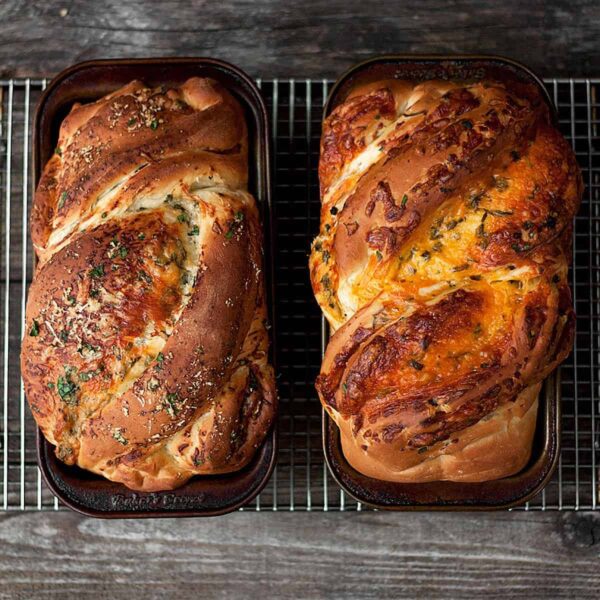
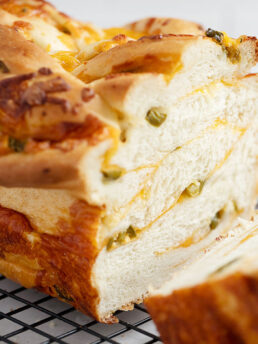
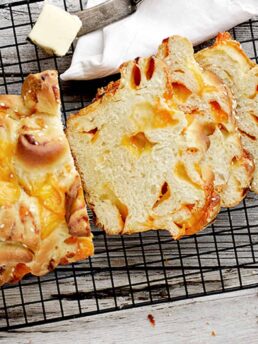
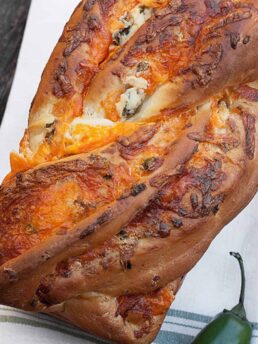

Can the second rise be done in the fridge overnight? I am a high school culinary tech teacher and need to stager the process over a couple of days.
Hi Roberta and yes, it could. It will still need some time out of the fridge in the morning I think though, before baking.
This bread was delicious I made one change, i added more cheddar cheese and it overflowed so the 2nd time I used 5×9 inch loaf pans and that fixed the problem and made slicing much easier as the top didn’t expand over the sides of the pan went over very well and have been asked to make again also it makes excellent grilled cheese
Glad you enjoyed it, Loren. Thanks!
This is my go to, beautiful & delicious bread for dinner parties! My friends and I love it!
Glad you are all enjoying it, Taylor. Thanks so much!
I have had this recipe on my reading list for a long time and finally made them both today. They are great. A bit more prep time than most bread but so worth the minimal extra effort. Loved too that they sliced so well. Expected a mess but nice even slices. Can hardly wait for toast in the morning.
So glad you enjoyed it, Patricia. Thanks so much!
Experienced cook but novice bread maker here. This was super easy and so yummy. I used the cheese we had on hand, cheddar and basil for one loaf and parmesan and mozzarella with oregano and basil for the other. My husband, who claims not to be a “bread guy” scarfed it down. Can’t wait to try this with sundried tomatoes
I’m so pleased to hear, Sandra! This is one of my favourite doughs to work with. I return to it often to create all kinds of things :)
This is my go to recipe to make pepperoni rolls with. I roll half the dough out about 1/4” thick and load it with layered sandwich pepperoni and provolone cheese. Roll them up tightly and slice to proof and bake. Always a crowd favorite!
Sounds delicious Katie! Such a great idea and another use for this beautiful dough :)
Absolutely delicious bread! I’ve made it multiple times and every time it does NOT disappoint. Delicious and fluffy!
So pleased you are enjoying it. Thanks!
Thanks for sharing this recipe, it came out exactly like I was hoping. It’s really tasty and taking my sandwiches to another level!
I’m so pleased to hear, Devon! Thanks so much :)
Amazing recipe! the dough was absolutely soft and so was the final product, even a day after. This is truly my go to bread recipe
I’m so pleased to hear, K. Thanks so much!
I made both loaves for a family get together over Christmas and everyone thought they where amazing so as a result I now have orders that every gathering from now on it’s Dad, Grandad, can you bake the loaves again. YES!! I will.
We all loved them….
I’m so glad to hear, Allan! You’ll be busy making these loaves, for sure :) Thanks!
5 star every make
Thanks so much, Barbara :)
About time I thank you for this recipe, love making 1 dough for 2 different gorgeous results. The roll-split-twist is genius & produces consistently better texture than a spiral or knead-in. I use Canadian apf & replace 30g w gluten (5g /cup/125g) to support the rise w all those goodies. Usually make 1 savory: orange x-old Cheddar 1# w a skim of Dijon, or grainy: 100g 12-grain or such hydrated with milk or water to make a stiff paste, sprinkle of cinnamon to highlight the grainy flavour, & 1 sweet: ch pecans-cin-br sugar or ch dried apricots orange zest & juice, ch prunes hydrated in oj &/ rum, endless possibilities, never a dud yet. Thank you, thank you.
So pleased you are enjoying this bread, Barbara. It’s one of my favourites! Thanks so much :)
This recipe came out perfect. I am new to baking and I had no problem with the instructions or video. The only thing I think that was left out was storing instructions. What’s the best way to store this bread when unfinished? I believe the fridge would be best, But how shorts should I wrap it?
So glad to hear, Jennifer! As for storing the bread, it really depends on your consumption rate. Storing in a plastic bag on the counter is best for the first 24-36 hours. After that, if there is a good bit left, I will freeze it. Bread freezes beautifully! I know it seems like the fridge would be a good option, but it tends to dry bread out quite quickly. I only opt for the fridge if I just have a bit left (not enough to bother freezing) and I want to stretch it another day or so for toast. Hope that helps.
Not sure what has happened but there is no video attached to this recipe. I can access other videos but not this particular one.
Hi Linda, it’s loading fine for me. You need to make sure that you have any ad blockers turned off to view the video. Otherwise, you might try refreshing the page or trying a different browser.
This made for a delicious snack. The crusty baked cheese on the outside and fused to the bread on the outside make it superb. I halved the recipe and made a variant on the cheddar herb bread. The only thing that confused me was that there were some very large bubbles in the finished product. Any comments? I tried watching the shaping video, but it wouldn’t load for me.
Hi Shaun, you may have to turn off any ad blockers to view the video. Watching the shaping video may provide the answer to your large bubbles. The shaping technique is quite tight, so it shouldn’t allow for large bubbles to form, unless the bread is really under-proofed before baking.
Bread sunk down in the center. Little disappointed. Did you punch your bread down?
Hi Megan, that can be disappointing and can happen for a number of reasons. I’m not a dough puncher, but I always gently deflate it after the first rise. In this bread, the act of rolling it really takes care of the deflating part. Bread that sinks can be under-kneaded (lack of structure) or over-proofed before baking (the yeast is spent before it hits the oven). Do either of those sounds likely in your case?